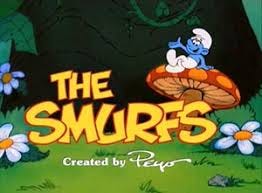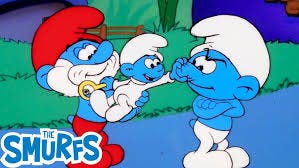This week, your weekly dose of animation comes from Europe but has been taken and developed brilliantly in the US. These little brilliant blues have made a fortune and stood the test of time.
The History
The Smurfs began their animated journey in 1981, debuting in the Saturday morning lineup on NBC in the United States. Created by Belgian cartoonist Pierre Culliford, known as “Peyo,” these tiny blue creatures first appeared in 1958 in the comic series Johan and Peewit. Their popularity soared, leading to the launch of a standalone series in 1981 produced by Hanna-Barbera Productions. The series aired from 1981 to 1989, amassing over 250 episodes across nine seasons, making it one of the longest-running Saturday morning cartoons. By cleverly adapting the European comic to an American audience, Peyo, alongside Hanna-Barbera, tapped into an international phenomenon, which became a hit among children and adults alike.
Peyo’s cherished characters were brought to life by a talented cast of voice actors. Paul Winchell voiced Gargamel, while Don Messick provided the voices for Papa Smurf and Azrael, Gargamel’s feline companion. Lucille Bliss portrayed Smurfette, the first and only female Smurf for many years. Although the iconic series concluded in 1989, its impact has proven timeless. In recent years, there have been efforts to rejuvenate the franchise, including the release of The Smurfs in 2011, a 3D CGI film, and Smurfs: The Lost Village in 2017, a fresh CGI-animated reboot with a modern twist on the original design.
The Characters
Although there are many characters, I have briefly overviewed the most influential.
Papa Smurf
The village leader, Papa Smurf, is recognisable by his red hat and trousers. He is the wise elder and voice of reason in the village. He is often depicted as a fatherly figure, guiding the Smurfs through challenging situations and offering sage advice.Smurfette
Created by the evil sorcerer Gargamel to sow discord, Smurfette’s transformation from antagonist to treasured village member is a critical storyline in the series. With her signature blonde hair and charm, Smurfette holds a special place in the heart of the village.Brainy Smurf
Known for his intellectual airs and relentless (often irritating) advice, Brainy is one of the more vocal members of the Smurf community. Despite his occasional arrogance, he remains a vital part of the group.Jokey Smurf
Always seen with a gift box primed for mischief, Jokey Smurf is the joker of the village. His pranks, often involving his exploding gifts, are iconic and a frequent source of comic relief.Clumsy Smurf
As his name suggests, Clumsy is constantly tripping over himself, but his heart of gold and sheer determination endear him to the others. His well-meaning but hapless nature leads to memorable moments.
The Plotlines
The general plotlines of The Smurfs revolve around the everyday adventures and occasional threats to their harmonious village. The primary antagonist, Gargamel, is a bumbling sorcerer with a single goal: capturing the Smurfs to either eat them (according to some iterations) or use them in magical potions. Episodes like The Smurfette explore themes of acceptance and transformation, while others, such as The Purple Smurfs, touch on issues of contagious misfortune. The stories are light-hearted, often teaching a simple moral without being heavy-handed, and every episode resolves with the Smurfs banding together to save their own.
Famous People
Notable celebrities have either contributed to or expressed their love for The Smurfs. In the 2011 and 2013 live-action films, Neil Patrick Harris and Katy Perry were prominent contributors, with Perry voicing Smurfette. Antonio Banderas and Hank Azaria also lent their talents to the adaptations of the movie. Celebrities such as Britney Spears and Beyoncé have expressed their love for the franchise, with Spears even contributing to the soundtrack of The Smurfs 2.
Popular Culture
The Smurfs became deeply ingrained in popular culture, spawning numerous merchandise, video games, and even songs. The La La Song, or The Smurfs’ Theme, became widely recognised, symbolising an era of carefree fun. Over the years, the series has seen updates in response to societal changes. Initially a damsel in distress, Smurfette has evolved into a more empowered character in modern iterations, reflecting changing perceptions of gender roles.
Advertising
The Smurfs' reach extended beyond the screen with several advertising collaborations. In the 1980s, the franchise joined McDonald’s to create a line of Happy Meal toys, an effective marketing strategy linking blue creatures to fast-food culture. More recently, the characters were used in campaigns promoting forest conservation efforts, highlighting how The Smurfs were not only a part of childhood entertainment but also a symbol of environmental awareness.
Spin-Offs and Related Work
Spin-offs have played a significant role in the franchise's longevity. Beyond the 2011 live-action adaptation and its sequels, video games like The Smurfs' Village have attracted millions of downloads. Merchandise ranged from figurines to various apparel, capitalising on the characters' distinctive blue appearance. The franchise’s merchandising success has brought in billions of dollars, firmly establishing The Smurfs as a valuable intellectual property.
Financials
In terms of financial success, The Smurfs has been a powerhouse. The 2011 movie grossed over $560 million worldwide, demonstrating that the brand’s appeal was still strong decades after the original series ended. The global Smurfs franchise, in its entirety, is estimated to be worth several billion dollars, encompassing comics, television, films, and merchandise.
Legacy
The Smurfs' legacy extends far beyond simple entertainment. They stand as a testament to how a simple concept can evolve into a worldwide phenomenon. The series introduced a generation of children to the charm of European comics and showed the impact of television animation in defining pop culture. The Smurfs’ village, language, and even their conflicts with Gargamel became metaphors for unity and perseverance, lessons not lost on those who grew up with the show.
Fun Facts
Peyo chose the Smurfs' colour, blue, after considering the other two primary colours, red and yellow. He felt blue was the most neutral choice.
The word “smurf” came about when Peyo momentarily forgot the word for “salt” and referred to it as “schtroumpf”, the original French name of the Smurfs.
The Smurfs is one of the few cartoons to be dubbed into nearly 30 different languages during its peak years.
Summing it all up
To sum up, The Smurfs have left an indelible mark on animation and popular culture. From their inception in the Belgian comics to their transformation into an American television staple, the Smurfs’ journey encapsulates the changing face of entertainment and how a simple village of blue characters can resonate across generations. Their appeal, transcending borders and languages, has shown the potential for animation to create universal stories that endure through time.
Ultimately, The Smurfs have done what few other animated series have: they’ve thrived across decades, inspired countless adaptations, and brought joy to audiences worldwide. If their history has shown anything, the most minor characters can sometimes have the most significant impact.
Feel free to share your opinions of our blue friends. I am again on the hunt for guest posts for the new year, so if you would like your people to call my people, let’s have a chat :)








They were everywhere and yet invisible. We saw them and, at the same time, took them for granted. I think that's what they taught us, something about the precious inevitablity of life. Life is there, in the small place, happening just beneath our eyes and we might not even know it.
The Smurfs were the highlight of my Saturday mornings. Most of the other cartoons were just fillers.